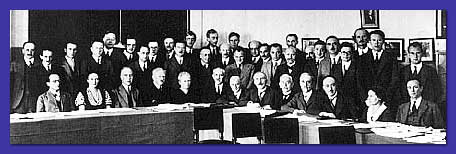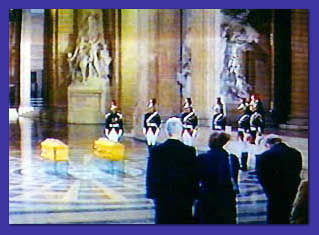Although she did
not believe that researchers were exposed to the same dangers as industrial
workers, she required the Radium Institute staff to have their blood
counts checked regularly. She also advised staff members to get regular
exercise and fresh air, as if these precautions would protect them
from radiation's harmful effects.
“Perhaps radium has something
to do with these troubles, but it cannot be affirmed with
certainty.” --letter from Curie
to her sister Bronya, November 1920
|
 |
| When Curie attended the
Solvay Congress of 1933, she was no longer, as in 1911, the
only woman in attendance. She is seated here to Langevin's left.
|
|
|
 OME
DAYS SHE WAS TOO SICK TO GO TO THE LAB. On those days she worked
at home on the manuscript of her book Radioactivity, which
would be published posthumously in 1935. At first her regimen of
diet and exercise worked. Yet her health continued to deteriorate.
Over the Easter holiday of 1934, she took a last trip with her sister
Bronya, during which she paid a final visit to her brother-in-law
Jacques Curie. In May she went home sick from the lab in mid-afternoon
and never returned. OME
DAYS SHE WAS TOO SICK TO GO TO THE LAB. On those days she worked
at home on the manuscript of her book Radioactivity, which
would be published posthumously in 1935. At first her regimen of
diet and exercise worked. Yet her health continued to deteriorate.
Over the Easter holiday of 1934, she took a last trip with her sister
Bronya, during which she paid a final visit to her brother-in-law
Jacques Curie. In May she went home sick from the lab in mid-afternoon
and never returned.
“In
the event of my death I give to the Radium Institute, of
Paris, for exclusive use in the Curie laboratory, the gram
of radium given to me by the Executive Committee of Women
of the Marie Curie Radium Fund...”
|
|
 |
| Today busts of Marie and
Pierre Curie stand in the garden of the Radium Institute,
now home to the Curie Museum. |
|
None
of the specialists who examined Curie could diagnose her problem.
Suspecting tuberculosis, several advised a stay at a sanatorium in
Switzerland. A medical expert from Geneva finally diagnosed a blood
disorder for which there was no cure. She died on July 4, 1934. “The
disease was an aplastic pernicious anemia of rapid, feverish development,”
the sanatorium director reported. “The bone marrow did not react,
probably because it had been injured by a long accumulation of radiations.”
|
 URIE
WAS BURIED TWICE On July 6, 1934, she was interred in the same
cemetery in Sceaux where her in-laws and Pierre lay. Over 60 years
later the remains of Pierre and Marie Curie were re-interred in France's
national mausoleum, the Panthéon, in Paris. Marie Curie thus became
the first woman whose own accomplishments earned her the right to
rest for eternity alongside France's most eminent men. URIE
WAS BURIED TWICE On July 6, 1934, she was interred in the same
cemetery in Sceaux where her in-laws and Pierre lay. Over 60 years
later the remains of Pierre and Marie Curie were re-interred in France's
national mausoleum, the Panthéon, in Paris. Marie Curie thus became
the first woman whose own accomplishments earned her the right to
rest for eternity alongside France's most eminent men.

|
| During the reinterment
of Pierre and Marie Curie at the Panthéon, the president of
France said, “As the country bows before her ashes...I
form the wish, in the name of France, that everywhere in the
world the equality of the rights of women and men might progress.” |
“By transferring these ashes of
Pierre and Marie Curie into the sanctuary of our collective
memory, France not only performs an act of recognition,
it also affirms a faith in science, in research, and its
respect for those who dedicate themselves to science, just
as Pierre and Marie Curie dedicated their energies and their
lives to science.”
--President François Mitterand at the Panthéon, April 1995
|
� 2000 -
American Institute of Physics
|
|

